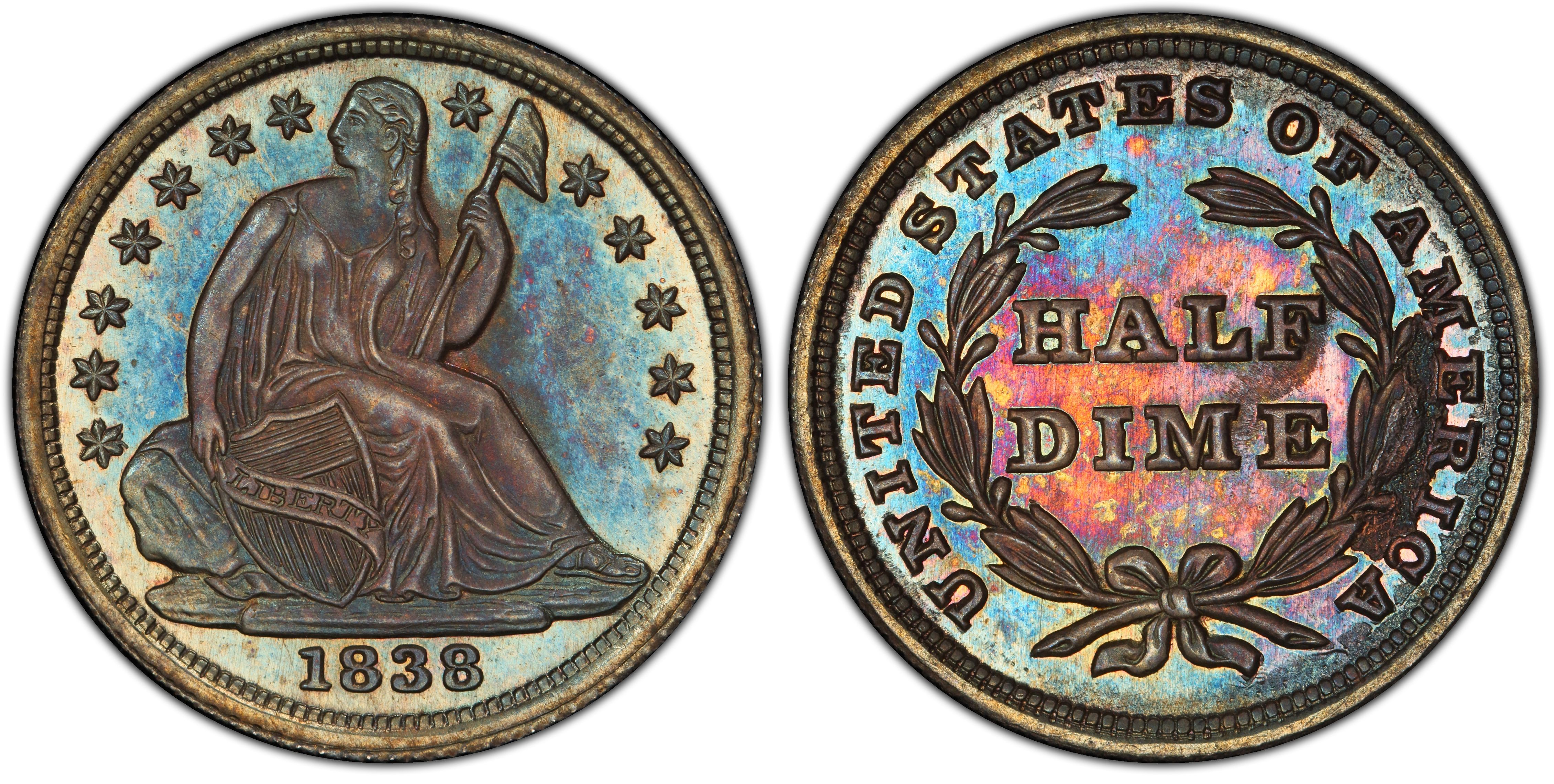Cool Seated NEWP -- and a grading question
The below coin is something I picked up a few months ago. Initially, the strike caught my eye as being an extremely weak reverse for a proof and I hoped it might be an improperly designated business strike.
After a bit of research, I'm convinced it's something much more interesting. Both the obverse and reverse diagnostics match up with Judd-333 which would make this a copper pattern.
The diagnostics I used for this comparison include:
Obverse date position and slope
Broken 'S' in states on obverse
Location and amount of reverse weakness
The coin is nicely toned, making the composition difficult to discern but central areas, particularly on the reverse do have a copper-like coloration.
What are the forum's thoughts? I tried contacting PCGS to request a re-holder with appropriate designation and was told that since the original submitter did not pay extra for pattern designation that they would not review for this, despite the evidence laid out. Do any more experienced submitters have advice on how to both maintain the grade while correcting the designation?
Thanks!


Comments
The toning on the coin is inconsistent with what I'd expect on a copper piece.
Mark Feld* of Heritage Auctions*Unless otherwise noted, my posts here represent my personal opinions.
Anything's possible I suppose but I'd be shocked if that was copper
Nice coin, it appears both the obverse and reverse of your coin were struck using dies associated with a Judd-333 listed on Coinfacts.
https://www.pcgs.com/cert/40276240

I'd ask myself if the copper counter-parts also share a weak reverse such as the OP's coin. If so, along with his other findings and conclusions he may well be on to something.
(Although as Feld pointed out, the toning doesn't appear to be consistent with a copper planchet.)
peacockcoins
The patterns I looked up displayed similar weakness on the reverse. At the same time, I viewed images of several non-patterns and none of them exhibited that characteristic. So, while the toning tells me the coin's likely a regular issue, its reverse strike causes me to consider otherwise. I'm intrigued.
Mark Feld* of Heritage Auctions*Unless otherwise noted, my posts here represent my personal opinions.
Thanks to those who have offered opinions so far and particularly to LJenkins11 for the thorough die marker analysis.
Interestingly, Judd-334 appears to be the same set of does used to make aluminum strikes. I’m not suggesting that my coin is struck in aluminum, rather wondering if it’s possible the “moonlight mint” may have struck some in normal silver as well. How would someone even go about determining coin composition once a coin is slabbed?
I think it’s silver. The mint probably just reused the other, practically brand-new dies.
Type collector, mainly into Seated. -formerly Ownerofawheatiehorde. Good BST transactions with: mirabela, OKCC, MICHAELDIXON, Gerard
Weight, or possibly a SIGMA.
Type collector, mainly into Seated. -formerly Ownerofawheatiehorde. Good BST transactions with: mirabela, OKCC, MICHAELDIXON, Gerard
Looks silver to me. Never would have assumed it to be copper.
The off-metal strikes of this era are in the vast majority of cases not patterns or trials, but struck for sale to collectors and were often restruck over a lengthy period of time. The roundness of the devices suggests that these were regular issue dies that were polished to create these restrikes. It is very feasible and in fact likely that silver planchets were used to create proofs at the time. Clearly this was struck fairly concurrently to the off-metal strikes as the thread strikethroughs indicate that there were pieces of thread that remained on the surface of the dies over the course of the striking of these two coins.
This is something that is likely much more common than is generally admitted with early to mid 1800s ”patterns” and proof coinage (especially those dated from the 1850s to 1870s), and market values often do not reflect the potential for pieces to not be original. Unfortunately in many cases, die features of backdated strikes are not as readily distinguishable as upon this piece.
Gobrecht's Engraved Mature Head Large Cent Model
https://www.instagram.com/rexrarities/?hl=en
The Heritage description for the Judd-333 example confirms the above: “This piece was made from the 1869 hub having broken 'S' in States and from an 1869 reverse hub with the die scratch angling upwards from the right wreath into the center." So this can be referred to as either a proof restrike, or given a separate Judd number with the argument that it is not quite a true proof since regular issue dies were used.
Gobrecht's Engraved Mature Head Large Cent Model
https://www.instagram.com/rexrarities/?hl=en
I've seen the same thing happen with some 1863 and 1864 half dime proofs.
Struck in some later year, using later hubs that were also used to strike off-metal coins.
We just designate them as a separate die marriage under the year shown, with another V- number.
You could report it to Gerry Fortin and probably get it designated as 1863 F-102.
In the 1837-1855 time frame, often regular issue dies (for several denominations) were polished and used to strike proofs on demand.

This is a somewhat recent discovery by John Dannreuther, and it has been discussed in this forum.
A good example is this 1838 V-10e, which has a big spalled or crumbled area on the reverse (under MERIC) and is a middle die state that is common in business strikes. This is a PR-67 from the Pittman and Gardner collections which sold for $129k in 10/2014. This is the third most expensive seated half dime, behind the unique 1870-s, and another 1837 proof with different dies that sold for $182k in 1/2014.